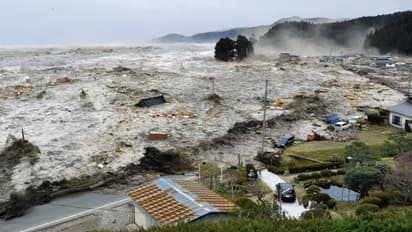Japan warns of MEGAQUAKE that could kill 300,000 people; experts predict huge tsunami waves

Synopsis
The Japanese government has issued an urgent warning over the catastrophic damage which could be caused by an impending megaquake.
The Japanese government has issued an urgent warning over the catastrophic damage which could be caused by an impending megaquake. Experts believe there is an 80 per cent chance of a magnitude nine tremor will strike the Nankai Trough off Japan's Pacific coast within the next 30 years.
New government estimates show that this disaster would kill 300,000 in the worst-case scenario. 215,000 deaths attributed solely to tsunami waves towering over 30 meters (98 feet) in some coastal zones.
The Nankai Trough, a 900-kilometer-long oceanic trench formed by the collision of tectonic giants, is hit by a megaquake once every 100-200 years.
The Cabinet Office's latest report, its first update since 2013, lays bare the scale of destruction: over 2.35 million buildings reduced to rubble, consumed by collapses, flooding, and infernos. The economic toll? A staggering £1.44 trillion (214.2 trillion yen) in damages. Meanwhile, 12.3 million people—roughly 10 percent of the country’s population—would be displaced, forced to flee shattered homes and rising waters.
Japan's perilous location along the Pacific Ring of Fire- the world's most seismically volatile zone- exposes it to frequent, large-scale earthquakes. An astonishing 81 per cent of global high-magnitude quakes erupt in this volatile belt.
The most vulnerable zone remains the Nankai Trench, a seismic powder keg that last stirred violently in 2023 with a magnitude 7.1 quake in southwestern Japan—prompting the government’s first-ever megaquake advisory for the region.
The government simulated the devastating aftermath of a magnitude-9 rupture—calculating the reach of tsunamis, structural collapses, and the resulting flood zones. Despite recent upgrades in building standards and sea walls, the report reveals only marginal improvements in predicted fatalities compared to the last decade.
What if megaquake hits?
If this megaquake strikes, 10 of Japan’s 47 prefectures will endure level-seven tremors—the highest on Japan’s earthquake severity scale—while 24 more will experience level-six shocks. An estimated 73,000 people will perish beneath crumbling structures, but the tsunami remains the deadliest threat, sweeping away everything in its path with terrifying velocity.
“Megaquakes push unimaginable volumes of ocean water,” scientists warn, “creating tsunami waves that surge across the sea at the speed of a commercial airliner.”
Japan’s collective memory still bears the scars of the 2011 Tohoku Earthquake, which killed 15,500 people and generated 40-meter waves that decimated coastal towns and caused the Fukushima nuclear disaster. But officials caution: a Nankai megaquake could eclipse even that catastrophe.
The report warns some coastal communities could have as little as two minutes before towering waves make landfall. Tokyo and 12 other southeast prefectures could be battered by 10-meter waves, while cities like Kuroshio and Tosashimizu in Kochi Prefecture face waves as high as 34 meters (112 feet).
The fallout would be staggering: 444 square miles (1,151.5 sq km) inundated with water at least 30cm deep, and, if the quake occurs at night in winter, when evacuation is most difficult, casualties could skyrocket.
The report estimates that 26,000 to 52,000 additional lives could be lost due to disease, exposure, and post-disaster conditions. “These indirect deaths,” the report states, “are 13 times higher than those recorded after the 2011 earthquake.”
Check the Breaking News Today and Latest News from across India and around the world. Stay updated with the latest World News and global developments from politics to economy and current affairs. Get in-depth coverage of China News, Europe News, Pakistan News, and South Asia News, along with top headlines from the UK and US. Follow expert analysis, international trends, and breaking updates from around the globe. Download the Asianet News Official App from the Android Play Store and iPhone App Store for accurate and timely news updates anytime, anywhere.